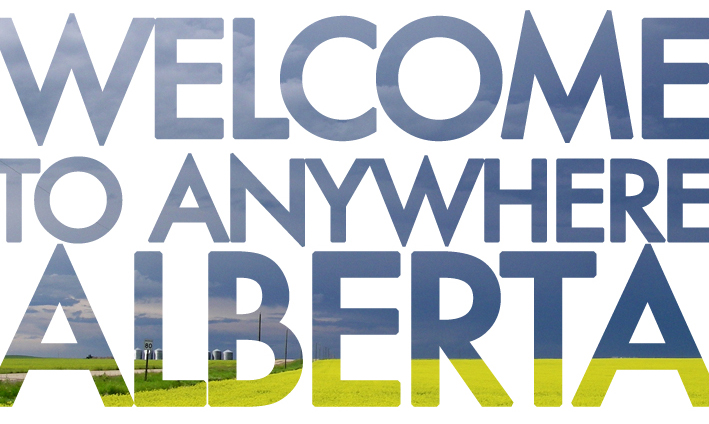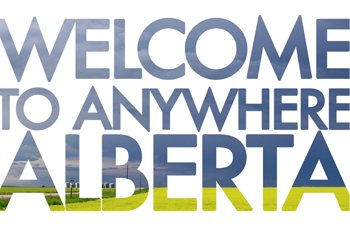
Community branding seems to be a growing trend across Alberta over the past few of years with places like Leduc, St. Albert, Strathcona County, Mayerthorp and even downtown Fort McMurray taking up the call.
The biggest challenge any community faces when tackling the concept of branding is just where to start.
- Do we start with creating a slogan that everyone likes to define us or do we design a new logo first and get people involved by voting on whether to accept it or not?
- Do we hire a consultant to do market research and surveys?
- Do we format all of our branding requirements into an RFP and put the brand services contract up for public tender, then hire an agency, and let them guide us through their processes?
- Do we assemble advisory or steering committees to provide community members with opportunities to be involved in the process? Who do we invite/select?
- Who should be leading the project and what relevant experience should they have?
- What should we expect our community to gain as the results of our branding campaign? More tourist dollars, business investment, residential appeal? How can we measure it?
- Does community branding include advertising campaigns, copywriting, photography or storytelling?
- How do we launch our new brand? Is it with new logos combined with our new slogan on everything? Do we have an unveiling party or a press conference? Do we engage in an advertising campaign?
Community Branding consultants and Communications experts seem to be in high-availability these days.
Each one offering their special secret to success, the one that will make your community brand “resonate” with targets like a magical tuning fork.
Before a community even begins to think about a comprehensive effort to strengthen a brand, it needs to first define itself—which leads to the two primary building blocks of any branding activity: the mission statement and positioning statement.
Building the Mission Statement
Whether the community is a renowned tourist destination, a thriving agricultural producer or a bedroom suburb, it needs a clear rationale for what its brand actually is — its purpose.
It also needs a vision that describes what its people want it to be — a clear attainable destination.
Our mission is to become…
In a mission statement the purpose and vision come together to serve as both the starting point and the linchpin of all the community’s branding and socio-economic development activities.
Mission statements can be elaborate or relatively brief. But in general they have the following key characteristics:
- Short and concise: Craft a statement that’s no longer than 75 words.
- Easily understood: Use plain language that is convincing and as memorable as possible.
- Broad: Don’t try to be all things to all people, but also don’t limit your community’s key attributes too narrowly.
- Visionary: Offer a vision of what your business aspires to be.
- Realistic: Temper your broad vision with realistic, workable goals.
- Motivational: Make a statement that will inspire commitment among community officials/employees, residents, businesses, and groups to achieve a common goal.

Defining your Community Brand
For example, let’s say that you are a bedroom suburb community. We’ll call your town “Rose of the North.”
- Your first order of business will be to solicit feedback from a “small” cross-section of informed community members. I say small, because the bigger the committee, the smaller your chance of developing and agreeing on what’s best for the community. Ultimately it are these men and women upon whom the success of your community’s mission depends.
- Next you’ll need to compile a list of words that describe your community: modern, traditional, tight-knit, ethnically diverse…; words that describe your ideal target audience’s image: affluent, well-travelled, modern, entrepreneurial, hard-working…; words that describe your ideal administrative image: trend-setting, experienced, young professional, conventional….
- Then you’ll need to start answering questions such as:
What residential, community and business needs does Rose of the North fulfill? We provide residents and businesses with a relaxed atmosphere, safety, spirit and support.
Who are we trying to attract? Our targets range from young professionals, married couples to retirees from the city and surrounding rural areas.
How will we measure our success? Our success will be measured by the satisfaction of our community members with the quality of life they achieve in our town. This can be indicated by the increase in enthusiasm and participation in events, initiatives and groups. Or, by increase in new residents, businesses and groups in the community.
Pulling the Mission Statement Together
When your mission statement building activities are complete, you’ll gather the information together, repeatedly editing it down until you arrive at a strong, compact statement that clearly guides the development of your community brand while inspiring commitment from its stakeholders (residents, businesses, administration, etc.) to achieve the mission.
For more information about community branding or creating a mission statement, contact us »
Stay tuned. In my next community branding article I’ll take you through the task of building a Positioning Statement.



3 Replies to “Community Branding: Where to Start? (Part 1)” .
Great information. Do you offer your services in BC?
Thank you Val. We sure do. I will follow up with you by email shortly to discuss.
Very Informative. Thanks
Comments are closed.